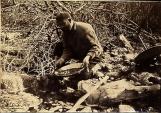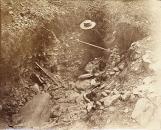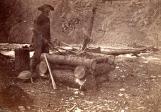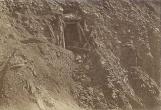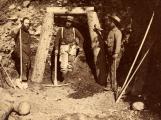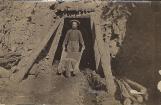1
Placer Gold MiningPlacer gold is "free" gold or gold which is loose in gravel beds deposited in ancient creek and river bottoms.
This gold can be retrieved without using heavy crushing machinery or chemicals. The gold is separated in gold pans and "sluiceboxes" by using water and movement. Since gold is very heavy the gold grains and nuggets sink to the bottom where they are trapped in mats.
3
Prospect hole Frying Pan Creek7 May 1898
Frying Pan Creek
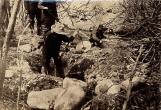 Credits:
Credits:(MacBride Museum Collection 1989.30.75)
4
ProspectingProspecting involves panning gravels from existing creek beds or pits dug in gravel seams from ancient creek or river beds.
These ancient beds can be seen in hillsides and exposed cuts. The gravels will are primarily made up of washed (rounded) rocks.
Because much of the Yukon has not been glaciated, modern creeks and rivers often follow the same course as the ancient beds.
5
Locating claims Union Gulch23 April 1898
Union Gulch
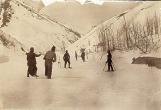 Credits:
Credits:(MacBride Museum Collection 1989.30.85)
6
Staking Placer ClaimsWhen the results of testing gravel beds produced gold, the ground was "claimed" by placing two stakes in the centre of the creek valley 250 feet apart.
The stakes or posts were inscribed with the date, the name of the staker, the name of the claim and the distance to the other stake.
8
Icons of the YukonThe tools of the trade - the gold pan with a crossed pick and shovel below - are used throughout the Yukon to denote placer gold mining and the rich mining heritage it symbolizes.
11
Digging DriftsThe gravel just above the bedrock usually contained the richest pay. When the gold was deposited in ancient times the rough bedrock acted as gold traps much like modern sluicebox riffles.
Digging a drift (or tunnel) into an exposed bank was one way of reaching this pay. Drifts were "cribbed" with wooden beams to prevent them from collapsing.
